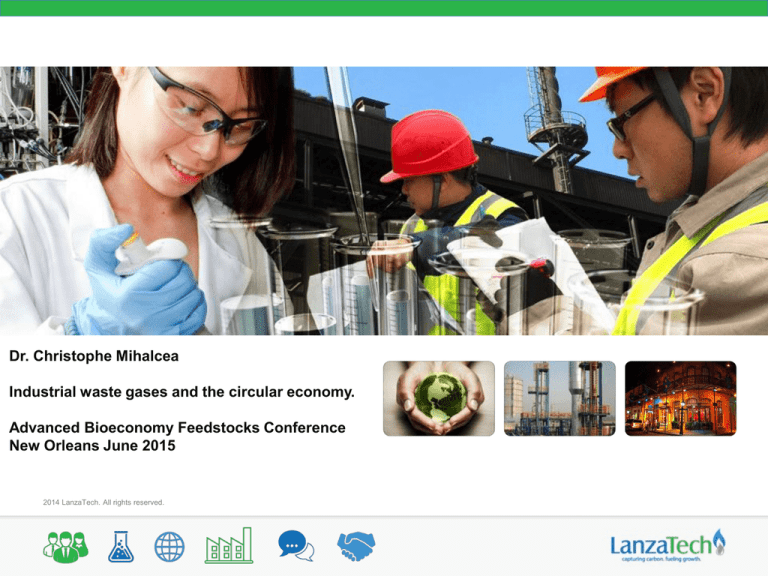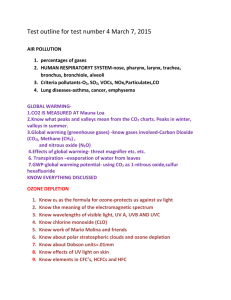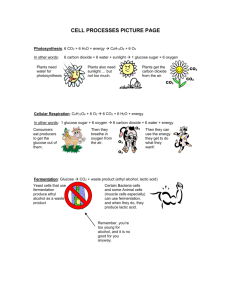
Dr. Christophe Mihalcea
Industrial waste gases and the circular economy.
Advanced Bioeconomy Feedstocks Conference
New Orleans June 2015
2014 LanzaTech. All rights reserved.
Use Carbon where Required
Recycle to Reduce Pressure on Reserves
Steel
Aluminum
Glass
Plastic
Carbon
C
Ore
Alum
Minerals
Oil
Oil
Carbon Reduction through Re-use and Recycling
Carbon Reduction through Re-use and Recycling
A 2-degree carbon budget will require countries to leave
80 % of coal, 50 % of gas and 33 % of global oil untouched.
Organization for Economic Growth and Development, Nature
3
The LanzaTech Process is Driving Innovation
Novel gas fermentation
technology captures CO-rich
gases and converts the carbon
to fuels and chemicals
Proprietary
Microbe
Gas Feed Stream
Gas Reception
Compression
Fermentation
• Process recycles waste carbon into fuels
and chemicals
• Process brings underutilized carbon into
the fuel pool via industrial symbiosis
• Potential to make material impact on the
future energy pool (>100s of billions of
gallons per year)
Recovery
Product
Tank
Waste carbon streams as a Resource
Industrial
Waste Gas
Biogas
Solid Waste
Steel, PVC, Ferroalloys
LFG, Methane
Industrial, MSW, DSW
~184.2T M3 *
>2B MTA *
~ 1.4B MTA (Steel only) *
Reforming
CO
CO + H2
Biomass
CO2
>1.3B MTA (US Alone) *
Gasification
CO + H2 + CO2
Renewable H2
CO2 + H2
CO2 + H2O + e-
Gas Fermentation
Available
High Volume/Low Intrinsic Value
Non-Food
*2010 global production; 2012 proven gas reserves data (IEA, UNEP, IndexMundi, US DOE Billion Ton Update)
Renewable
Electricity
Most Point Sourced
Steel Gases: 30Bn Gal Ethanol Capacity
Iceland
RUSSIA
1,830
USA
W. EUROPE
925
4,870
United
States
Russia
Kazakhistan
E. EUROPE
CHINA
S. KOREA
10,800
1,270
China
1,300
Mexico
JAPAN
Thailand
BRAZIL
INDIA
955
Brazil
3,750
Indonesia
1,315
Australia
Argentina
Country
Potential Ethanol Production Capacity (MMGPY)
Steel Mills (>5 MT/year)
TOTAL
27,015 MMGPY
6
Proprietary Acetogenic Biocatalyst
Acetogenic bacterium with ability to utilize gases as sole energy and carbon source
– CO
– CO+H2 or CO+CO2+H2
– CO2+H2
LanzaTech has developed a proprietary
strain of Clostridium autoethanogenum
Obtained by extensive natural selection program, having improved characteristics over parent
– High gas uptake and ethanol production rates
– Fast growth on defined minimal media
– Non-sporulating and non-motile
1
Sequencing revealed several variations
to parent
Deletion
Variation
Insertion
Rearrangement
7
Why does it matter?
CO2
5.2 barrels of gasoline
are displaced by every
tonne of ethanol
produced
1 tonne ethanol produced
as CO averted from flare
The LanzaTech Process
Gas Feed Stream
Gas reception CompressionFermentation
CO
Recovery Product
tank
Per tonne of LanzaTech Ethanol
CO2 MT
kg PM
kg NOx
Averted from flare
2.1
0.6
4.1
Displaced gasoline
+0.5
+2.5
+7.4
Energy required for
LanzaTech Process
-0.8
-0.2
-0.8
Avoided per
tonne of ethanol
1.8
2.9
10.7
Recycling Waste Gases Produces Low Carbon Fuels
Reduce GHG Emissions
NOx, SOx, Particulates
50-70% GHG
Reduction over
Petroleum Gasoline
Flare
Waste
Gases
Life Cycle GHG Emission
Flaring and power genera on
= combus on of carbon
Electricity
Generation
Electricity
Ethanol
Grid
Gasoline Pool
Recycling
= conversion of carbon
120
gCO2 e/MJ
100
90
80
Reduce Air Pollutants
60
33
40
20
0
Conventional
Gasoline
LanzaTech
Ethanol
Life Cycle Analyses (LCA) performed in cooperation with ,
>85% reduction in NOx and
Particulate Matter compared
to combustion at a typical
US steel mill
Michigan Tech University,, Roundtable on Sustainable
Biomaterials (RSB), E4Tech, and Tsinghua University
9
Broader Environmental Impact
NOx
&
Particulates
LanzaTech Process emits ~40%
less NOx and ~80% fewer particulates
than electricity generation per MJ
energy recovered
Steel production
Electricity
Generation
Steel Mill
Waste
Gases
Electricity
Grid
LanzaTech Process emits
33% less CO2 than
electricity generation per
MJ energy recovered
LanzaTech
Process
Ethanol
Gasoline Pool
Carbon is Only Part of the Story
The LanzaTech Process: Ready for Deployment Today
Gas fermentation technology
converts
C-rich gases to fuels and
chemicals
Gas Feed Stream
Proprietary
Microbe
Gas Reception Compression Fermentation
Recovery
40,000 combined hours on stream
Multiple runs exceeding 2000 hours
Multiple plants at various scales
demonstrating different key aspects of process
Product
Tank
Pre commercial steel mill demonstrations
Performance milestones
exceeded
First commercial in design; fully
financed in China
Exceeded design capacity
Local chemicals, water
Shougang
WBT (CSC/LCY)
Mitigating Scale up Risk through
Successful Technology
Demonstration
Bao
Glenbrook
The LanzaTech Process
Proprietary
Microbe
Gas fermentation
technology converts Crich gases to fuels and
chemicals
Gas Feed Stream
Gas Reception Compression Fermentation
Performance milestones achieved and exceeded for >1000 hours
Recovery
Product
Tank
1 Organism, over 20 Products…
1 Organism, over 25 Products…
Discovery
Biodiesel (FAEE)
3-Hydroxypropionate (3-HP)
Jet Fuel
Isoprene
Aromatics
Fatty Acids,
Terpenoids
Aromatics
CO/H2
Pyruvate
Amino Acids
Acetoin
Acetyl-CoA
2-Butanol
Partnerships
1,3-Butadiene
1-Propanol
1,2-Propanediol
Biopolymers
Methyl Ethyl Ketone (MEK)
Butylene
Succinate
Butyrate
3-Hydroxy
Butyrate (3-HB)
Lactate
1-Butanol
1,3-Butanediol (1,3-BDO)
Acetone
Isopropanol
Acetate
Ethanol
2,3-Butanediol (2,3-BDO)
Lab Scale
Process
Scaled-Up
Process
C4 Chemicals from Gases: BDO/Butadiene
Two Step Route:
1. Butanediol production
OH
CO + H2
H3 C
CH3
OH
Direct route:
Developing
a Butadiene
producing
organism
2. Catalytic conversion
2,3-Butanediol
Catalytic Dehydration
H
H
C
C
H
H
C
3
H
C
H
H
1,3-Butadiene
1
C
H
CH2
Reductive Elimination
4
CH3
1
4
H3C
2
2
C
C
H
1-Butylene
(But-1-ene)
CH3
Catalytic Dehydration
1
3
C
C
H
O
H
H
2-Butylene
(But-2-ene)
H
CH3
2
C
H3C-CH2-C
CH3
3
CH3
Isobutylene
(2-Methylpropene)
Methyl Ethyl Ketone
(MEK/Butanone)
Butenes
New Route to C4s Without Current Supply Challenges
15
New pathways: CO2 as Carbon Source
Lipid Product Markets
Hydrocarbon Transport Fuels
>US $ 3 trillion/year
Long Chain
Fatty Acids
Algae/Yeast
Biomass
Omega 3
Fatty Acids
Acetate to
Lipids
Medium/Long
Chain
Fatty Acids
Omega 3
Fatty Acids
Animal Feeds
US $370 billion/yr
Food, Nutritional Supplements
US $25 billion/yr
Oleochemicals
US $15 billion/yr
17
Conversion of Acetic Acid to Lipids
Carbon
Source
Lipid Profile of Yeast using Acetate
peak area
CO2
Energy
Source
H2
Lipid Profile of Algae using Acetate
99%
1.4E+10
1.2E+10
1E+10
8E+09
6E+09
4E+09
Lipids are
predominantly
saturated C16 &
C18
2E+09
7:0
8:0
9:0
10:0
12:0
12:0
12:0
14:0
14:0
16:0
18:1
18:1
18:0
19:1
20:1
20:0
22:1
22:0
23:0
24:1
24:0
0
Acetate
Direct feed, no purification
C:double bonds
•
•
•
Work done in a collaboration
with Prof Kent Zhao of the Dalian
Institute of Chemical Physics.
•
Strains identified that grow of
LanzaTech broth using acetate as
Yeast
algae
the sole source of carbon and
2nd fermentation
energy.
Acetate to Lipid conversion by yeast or algae •
Patent filed, optimization underway
•
Yeast accumulate lipids to >70%
of their cell mass.
•
Work done in a collaboration with Advanced BioEnergy Research Centre at Indian Oil Corporation IOC.
Strains identified that grow of LanzaTech broth
using acetate as the sole source of carbon and
energy.
Algae accumulate lipids to >50% of their cell
mass.
25% of lipids content are Omega-3 fatty acids
(Specifically DHA).
18
Acetic acid production from H2/CO2 using A. woodii in
LanzaTech’s single fermenter system setup
• Step change in achievable
acetate broth concentration
(from 2.5 to 4wt%)
• Optimized media recipe
• Stable high level production
• Acetic acid production rates at 180g/L/d at a concentration of 30g/L were
achieved in single fermenter system.
• Selectivity of acetic acid is ~95% as no other products apart from biomass is
produced
19
Lipid composition of acetate–fed algae
Acetate consumption rates: ~80g/L/d
Lipid Composition:
• Constant across dilution rates
• Consistently ~22% of lipids = DHA omega-3 fatty acid
20
“Electrosynthesis” the next step for LanzaTech
Bacteria that use gases such as CO2 as their source of carbon derive the energy needed
from electrons.
Sources of
electrons:
Wind
Solar
electrical
energy
Biomass
CO2
CO2
eLanzaTech converts CO2 and electrons to products with no run-off, land use
change, or environmental uncertainty issues associated with crops
Crops convert CO2 and solar energy in to
Biomass
• LanzaTech bacteria can ferment CO2 and H2
• LanzaTech have shown enhanced reactor performance with electron-assisted fermentation (Patent
application: US61/295,145)
• Prof. Derek Lovley at U Mass (Amherst) is the leading researcher in this “electrofuels” field
• Prof. Lovley and LanzaTech are establishing a joint research effort (government funded) in this area
• This work is a natural extension of the microbial, synthetic bio, and engineering work being undertaken
on the LanzaTech platform
Natural feedstock extension of the LanzaTech Platform technology
LanzaTech Global Partnerships








